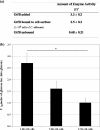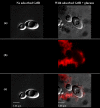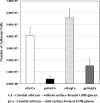Role of glucosyltransferase B in interactions of Candida albicans with Streptococcus mutans and with an experimental pellicle on hydroxyapatite surfaces
- PMID: 21803906
- PMCID: PMC3187131
- DOI: 10.1128/AEM.05203-11
Role of glucosyltransferase B in interactions of Candida albicans with Streptococcus mutans and with an experimental pellicle on hydroxyapatite surfaces
Abstract
Candida albicans and mutans streptococci are frequently detected in dental plaque biofilms from toddlers afflicted with early childhood caries. Glucosyltransferases (Gtfs) secreted by Streptococcus mutans bind to saliva-coated apatite (sHA) and to bacterial surfaces, synthesizing exopolymers in situ, which promote cell clustering and adherence to tooth enamel. We investigated the potential role Gtfs may play in mediating the interactions between C. albicans SC5314 and S. mutans UA159, both with each other and with the sHA surface. GtfB adhered effectively to the C. albicans yeast cell surface in an enzymatically active form, as determined by scintillation spectroscopy and fluorescence imaging. The glucans formed on the yeast cell surface were more susceptible to dextranase than those synthesized in solution or on sHA and bacterial cell surfaces (P < 0.05), indicating an elevated α-1,6-linked glucose content. Fluorescence imaging revealed that larger numbers of S. mutans cells bound to C. albicans cells with glucans present on their surface than to yeast cells without surface glucans (uncoated). The glucans formed in situ also enhanced C. albicans interactions with sHA, as determined by a novel single-cell micromechanical method. Furthermore, the presence of glucan-coated yeast cells significantly increased the accumulation of S. mutans on the sHA surface (versus S. mutans incubated alone or mixed with uncoated C. albicans; P < 0.05). These data reveal a novel cross-kingdom interaction that is mediated by bacterial GtfB, which readily attaches to the yeast cell surface. Surface-bound GtfB promotes the formation of a glucan-rich matrix in situ and may enhance the accumulation of S. mutans on the tooth enamel surface, thereby modulating the development of virulent biofilms.
Figures






Similar articles
-
Binding Force Dynamics of Streptococcus mutans-glucosyltransferase B to Candida albicans.J Dent Res. 2015 Sep;94(9):1310-7. doi: 10.1177/0022034515592859. Epub 2015 Jul 2. J Dent Res. 2015. PMID: 26138722 Free PMC article.
-
Candida albicans mannans mediate Streptococcus mutans exoenzyme GtfB binding to modulate cross-kingdom biofilm development in vivo.PLoS Pathog. 2017 Jun 15;13(6):e1006407. doi: 10.1371/journal.ppat.1006407. eCollection 2017 Jun. PLoS Pathog. 2017. PMID: 28617874 Free PMC article.
-
Bacterial GtfB Augments Candida albicans Accumulation in Cross-Kingdom Biofilms.J Dent Res. 2017 Sep;96(10):1129-1135. doi: 10.1177/0022034517714414. Epub 2017 Jun 12. J Dent Res. 2017. PMID: 28605597 Free PMC article.
-
Biology of Streptococcus mutans-derived glucosyltransferases: role in extracellular matrix formation of cariogenic biofilms.Caries Res. 2011;45(1):69-86. doi: 10.1159/000324598. Epub 2011 Feb 23. Caries Res. 2011. PMID: 21346355 Free PMC article. Review.
-
Multifaceted roles of Candida albicans and Streptococcus mutans in contributing to polybiofilm infections in early childhood caries.Front Cell Infect Microbiol. 2025 Jun 27;15:1625103. doi: 10.3389/fcimb.2025.1625103. eCollection 2025. Front Cell Infect Microbiol. 2025. PMID: 40654570 Free PMC article. Review.
Cited by
-
Antimicrobial and antibiofilm activities of Casearia sylvestris extracts from distinct Brazilian biomes against Streptococcus mutans and Candida albicans.BMC Complement Altern Med. 2019 Nov 12;19(1):308. doi: 10.1186/s12906-019-2717-z. BMC Complement Altern Med. 2019. PMID: 31718633 Free PMC article.
-
Human Tooth as a Fungal Niche: Candida albicans Traits in Dental Plaque Isolates.mBio. 2023 Feb 28;14(1):e0276922. doi: 10.1128/mbio.02769-22. Epub 2023 Jan 5. mBio. 2023. PMID: 36602308 Free PMC article.
-
Topical Application of 4'-Hydroxychalcone in Combination with tt-Farnesol Is Effective against Candida albicans and Streptococcus mutans Biofilms.ACS Omega. 2022 Jun 22;7(26):22773-22786. doi: 10.1021/acsomega.2c02318. eCollection 2022 Jul 5. ACS Omega. 2022. PMID: 35811935 Free PMC article.
-
Streptococcus gordonii glucosyltransferase promotes biofilm interactions with Candida albicans.J Oral Microbiol. 2014 Jan 29;6. doi: 10.3402/jom.v6.23419. eCollection 2014. J Oral Microbiol. 2014. PMID: 24490004 Free PMC article.
-
Streptococcus mutans extracellular DNA is upregulated during growth in biofilms, actively released via membrane vesicles, and influenced by components of the protein secretion machinery.J Bacteriol. 2014 Jul;196(13):2355-66. doi: 10.1128/JB.01493-14. Epub 2014 Apr 18. J Bacteriol. 2014. PMID: 24748612 Free PMC article.
References
-
- Banas J. A., Vickerman M. M. 2003. Glucan-binding proteins of the oral streptococci. Crit. Rev. Oral Biol. Med. 14: 89–99 - PubMed
Publication types
MeSH terms
Substances
Grants and funding
LinkOut - more resources
Full Text Sources
Other Literature Sources

